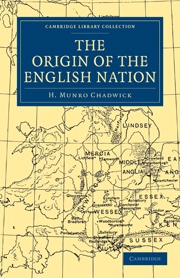Book contents
- Frontmatter
- PREFACE
- Contents
- CHAPTER I ENGLAND IN THE SIXTH CENTURY
- CHAPTER II THE WEST SAXON INVASION
- CHAPTER III THE INVASION OF KENT
- CHAPTER IV THE SAXONS, ANGLES AND JUTES IN BRITAIN
- CHAPTER V THE SAXONS, ANGLES AND JUTES ON THE CONTINENT
- CHAPTER VI THE KINGS OF ANGEL
- NOTE. THE EARLY KINGS OF THE DANES
- CHAPTER VII THE AGE OF NATIONAL MIGRATIONS
- CHAPTER VIII THE SAXONS AND ANGLES IN ROMAN TIMES
- CHAPTER IX THE CLASSIFICATION OF THE ANCIENT GERMANI
- CHAPTER X THE CULT OF NERTHUS
- CHAPTER XI KING AETHELWULF'S MYTHICAL ANCESTORS
- CHAPTER XII SOCIAL CONDITIONS OF THE ROMAN PERIOD
- ADDENDA
- INDEX
- Plate section
CHAPTER II - THE WEST SAXON INVASION
Published online by Cambridge University Press: 07 September 2010
- Frontmatter
- PREFACE
- Contents
- CHAPTER I ENGLAND IN THE SIXTH CENTURY
- CHAPTER II THE WEST SAXON INVASION
- CHAPTER III THE INVASION OF KENT
- CHAPTER IV THE SAXONS, ANGLES AND JUTES IN BRITAIN
- CHAPTER V THE SAXONS, ANGLES AND JUTES ON THE CONTINENT
- CHAPTER VI THE KINGS OF ANGEL
- NOTE. THE EARLY KINGS OF THE DANES
- CHAPTER VII THE AGE OF NATIONAL MIGRATIONS
- CHAPTER VIII THE SAXONS AND ANGLES IN ROMAN TIMES
- CHAPTER IX THE CLASSIFICATION OF THE ANCIENT GERMANI
- CHAPTER X THE CULT OF NERTHUS
- CHAPTER XI KING AETHELWULF'S MYTHICAL ANCESTORS
- CHAPTER XII SOCIAL CONDITIONS OF THE ROMAN PERIOD
- ADDENDA
- INDEX
- Plate section
Summary
The story of the West Saxon invasion is given only by the Chronicle. Bede makes no reference to it; indeed Ceawlin is the first king of Wessex whom he mentions. Later writers seem to have had no other materials than the Chronicle. The story as it appears in the Chronicle is as follows:
495. Two princes, Cerdic and Cynric his son, came to Britain with five ships, (arriving) at a place which is called Cerdicesora, and the same day they fought against the Welsh.
501. Port and his two sons, Bieda and Maegla, came to Britain at a place which is called Portesmutha (Portsmouth) and slew a young British man, a very noble man.
508. Cerdic and Cynric slew a British king, whose name was Natanleod, and five thousand men with him. The district was afterwards (or ‘in consequence’) called Natanleag as far as Cerdicesford.
514. The West Saxons, Stuf and Wihtgar, came to Britain with three ships, (arriving) at a place which is called Cerdicesora; and they fought against the Britons and put them to flight.
519. Cerdic and Cynric began to reign; and the same year they fought against the Britons at a place which is now called Cerdicesford.
527. Cerdic and Cynric fought against the Britons at a place which is called Cerdicesleag.
530. Cerdic and Cynric obtained possession of the Isle of Wight and slew a few men at Wihtgaraesburg.
534. Cerdic died and his son Cynric continued to reign for twenty-six years. They had given the Isle of Wight to their two nefan, Stuf and Wihtgar.
544. Wihtgar died and was buried at Wihtgaraburg.
[…]
- Type
- Chapter
- Information
- The Origin of the English Nation , pp. 19 - 32Publisher: Cambridge University PressPrint publication year: 2010First published in: 1924



